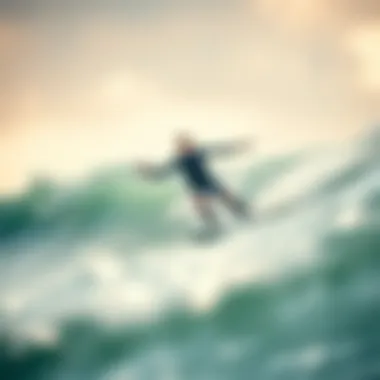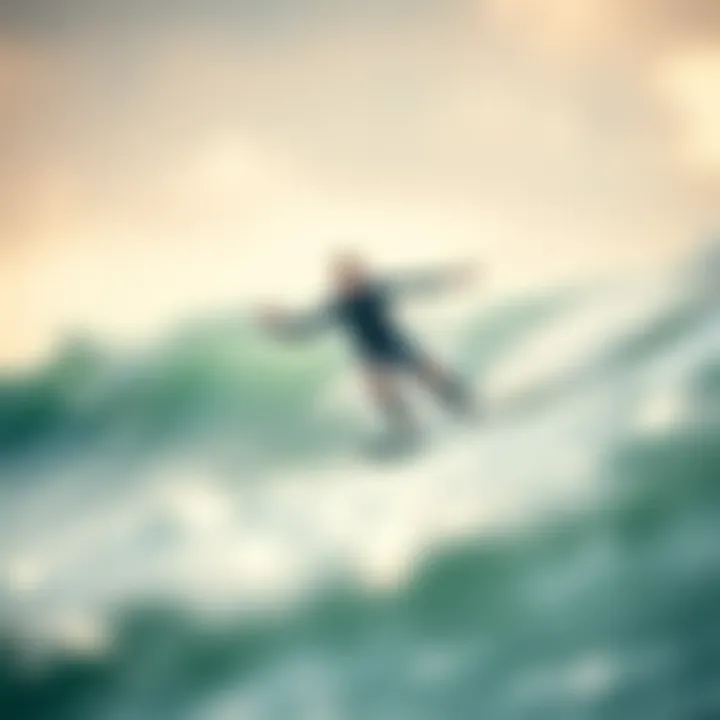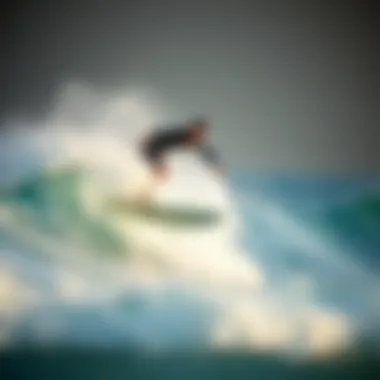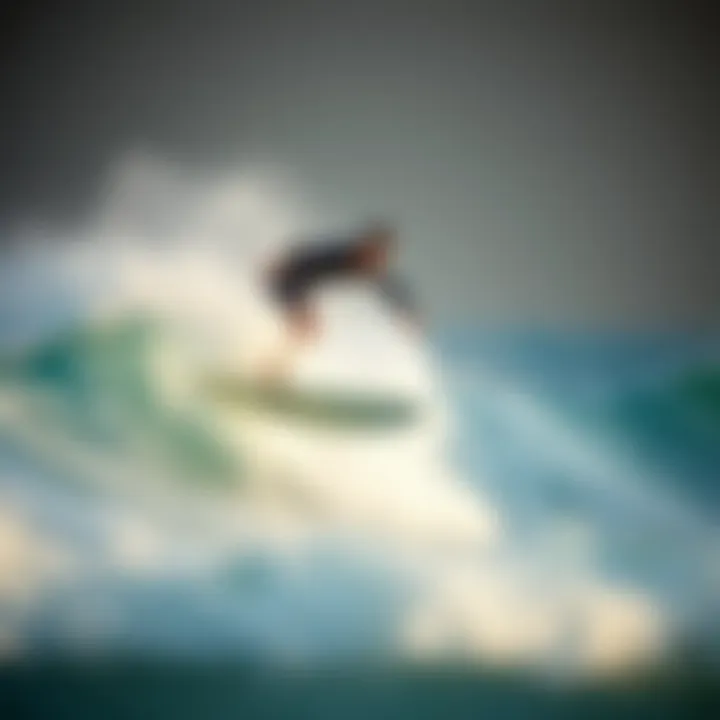Discovering the Thrill of Water Foil Surfing


Intro
Water foil surfing has recently captured the imagination of outdoor enthusiasts, creating waves of excitement within both the surfing community and beyond. As we dive into this innovative discipline, it's crucial to appreciate its unique blend of traditional surfing and advanced hydrofoil technology. This dynamic sport transcends the ordinary, offering thrilling experiences on the water while connecting riders with nature in a fresh and exhilarating way.
This article will unravel the essential components of water foil surfing, covering everything from gear and techniques to safety considerations and the profound cultural impact of the sport. Understanding the intricacies of water foil surfing is essential, whether you're a curious beginner or a seasoned wave rider looking to expand your horizons.
Surfing Techniques
Beginner Tips for Getting Started
Starting in water foil surfing can feel like learning to walk all over again. Foremost, one must acclimate to the sensation of riding a hydrofoil. Unlike traditional surfing, where you rely heavily on the board's surface, foil surfing depends more on mastering balance. Here are key pointers to set the stage for a solid foundation:
- Choose the Right Conditions: Ideal surf conditions for beginners are smaller waves and light winds. This helps in reducing the chances of wipeouts and fosters comfort on the foil.
- Start with a Bigger Wing: Larger wings provide more lift and stability, making it easier to get up and ride. This setup is excellent for novice surfers learning to control their balance.
- Practice on Flat Water: Before hitting the waves, practicing in flat water can significantly boost your confidence. Use a calm lake or a bay to get a feel for the hydrofoil's dynamics.
- Get Comfortable with Falling: Falling is an inevitable part of learning. Knowing how to fall wisely can save you from injuries; aim to fall away from the board and minimize the chance of landing on your gear.
Getting the hang of these basics helps set a solid foundation for future progress.
Advanced Maneuvers and Tricks
Once you've found your footing, the allure of advanced water foil tricks starts to beckon. These maneuvers not only boost your skills but enhance your enjoyment of the sport:
- Tacks and Gybing: These are fundamental navigation techniques that allow riders to change direction smoothly while retaining speed. With practice, you'll be gliding seamlessly through turns.
- Air Tricks: Once you feel confident, venturing into aerial tricks can be thrilling. The key is to generate enough speed before attempting, and proper timing is crucial to ensure safe landings.
- Carving: Carving involves executing sharp turns while maintaining speed. This not only enhances performance but also adds a dynamic flair to your riding.
"The thrill of flying above the water is unlike anything else; every glide feels like embracing freedom itself."
Mastery of these techniques will enrich your foil surfing experience, pushing your skills and confidence to new heights.
Surfboard Selection
Choosing the Right Board for Your Style
Selecting a surfboard tailored to your specific style is pivotal when it comes to water foil surfing. Several factors need consideration:
- Size and Volume: A board that's too small can make balancing difficult, especially for beginners. Conversely, an oversized board may compromise maneuverability. Finding a balance based on your weight and skill level is essential.
- Construction Materials: Surfboards come in various materials like epoxy and traditional fiberglass. Each material affects buoyancy and durability. For those just starting out, an epoxy board often offers a more forgiving and lighter ride.
- Foil Compatibility: Ensure that the board and foil system are compatible. Discrepancies can hinder performance and lead to frustrations while riding.
Surfboard Maintenance and Care
Caring for your surfboard is as important as riding it. Proper maintenance enhances its longevity and performance:
- Regular Inspections: Check for any dings or scratches regularly. Small damages can lead to larger issues if left unattended.
- Storage Solutions: Always store your board in a cool, dry place, away from direct sunlight. Invest in a protective board bag for added safety during transport.
- Cleaning: Rinse your board after every surf session to prevent saltwater corrosion or mold.
Maintaining your board not only ensures you’re safe on the water but also enhances the overall riding experience.
With a solid understanding of techniques and equipment, riders can immerse themselves deeper into water foil surfing's vibrant culture while pushing the boundaries of their skill set.
Understanding Water Foil Surfing
Water foil surfing is an increasingly popular sport that melds the thrill of surfing with the cutting-edge technology of hydrofoils. This innovative discipline transforms the way surfers interact with water, providing a unique and exhilarating experience that goes beyond traditional wave riding. Understanding the core elements of this sport is pivotal for both enthusiasts and newcomers alike.
The essence of water foil surfing lies in its ability to lift riders above the surface, allowing for smoother glides and the ability to catch waves that might otherwise be too small or inconsistent. This lift is created by a hydrofoil—a wing-like structure mounted beneath the board. As the rider gains speed, the foil generates lift, lifting the board and its rider out of the water. This allows for a sensation akin to flying, providing an unmatched level of thrill and versatility.
Benefits of Water Foil Surfing:
- Increased Wave Accessibility: Water foil surfing opens the door to waves that average surfers typically miss. The ability to catch small bumps or swell means more time on the water.
- Smooth and Quiet Ride: The hydrofoil’s design minimizes resistance and enhances ride smoothness. This is not just helpful for the surfer, but also provides a more tranquil experience on the water.
- Less Impact on Local Ecosystems: Because surfers can glide over shallower waters and avoid breaking swells, they generally have less impact on marine life when compared to traditional surfing.
As the sport evolves, environmental considerations must also be taken into account. Surfers should strive to balance the excitement that comes from the sport with the need to protect marine environments. The growing community of water foil surfers is exploring guidelines to ensure sustainability and minimize impacts on ecosystems. Learning about these considerations is crucial in order to not only enjoy the sport but also respect the waterways that provide it.
In essence, a deeper understanding of water foil surfing empowers individuals to appreciate not only the joy it brings but also the responsibilities that come with it. Whether it's choosing the right equipment, respecting local environments, or developing skills, this awareness enhances the overall experience, ensuring that water foil surfing remains a thrilling and responsible pursuit for years to come.
The Fundamentals of Foil Technology
At the heart of water foil surfing is foil technology, which essentially consists of a mast, a fuselage, and wings. These components work in unison to create lift as the rider moves through the water. Typically made from lightweight materials such as carbon fiber or aluminum, the modern foil setup optimizes performance while minimizing weight.
- Mast: This is the vertical component that connects the board to the wings. Masts come in various lengths, and the choice often is dependent on the rider's skill level and preferences.
- Fuselage: This connects the mast to the wings and affects the overall stability of the setup. A longer fuselage can provide more stability; however, it may sacrifice maneuverability.
- Wings: The wings are critical as they determine how much lift is generated and how the board responds to the water. Different wing shapes and sizes cater to different riding styles and conditions.
Understanding these components helps surfers make informed choices about their gear and optimize performance according to personal preferences and riding styles.
Historical Context
The roots of foil surfing can be traced back to the 1960s when inventors and surfers began experimenting with hydrofoil designs. It was a long time before the concept gained traction, with the technology becoming more refined in the late 20th century. The sport began to gain popularity in the early 2000s when paddleboarding surged in prominence; surfers began to incorporate foils into their boards.
The advancement of material science and engineering also played a crucial role in the evolution of foil surfing. The integration of lightweight materials such as carbon fiber contributed significantly to the sport hitting its stride in the surfing community. Today, water foil surfing continues to evolve with new designs, technologies, and advancements that will shape its future for years to come.


Essential Equipment for Water Foil Surfing
Water foil surfing requires equipment that not only enhances performance but also offers safety and enjoyment. The right gear can make a world of difference on the water, influencing how well a rider can connect with their surroundings and experience the thrill of gliding above the water's surface. Understanding the essentials is crucial for both beginners and seasoned surfers.
Choosing the Right Foil Board
Selecting a foil board is a pivotal first step for anyone venturing into water foil surfing. The board needs to align with your skill level and intended style of surfing.
- Length and Width: Beginners often benefit from longer and wider boards to maintain stability and control. These boards typically offer more surface area, which assists in getting the foil up and out of the water. On the other hand, advanced surfers might opt for shorter and narrower options, which enable sharper turns and greater maneuverability.
- Volume: The volume of the board plays a significant role in buoyancy. A higher volume board will float better, making it easier to paddle and get into the surf. Conversely, lower volume boards are favored for their performance in bigger waves.
- Shape: Different shapes suit various conditions. For instance, a board with a rounded nose can navigate through choppy waters more easily, while a pointed nose might perform better in cleaner conditions.
Ultimately, the right board can affect everything from your balance to your ability to catch waves, so take the time to consider all aspects before making a choice.
Foil Types and Their Characteristics
Understanding the different types of foils available is essential for tailoring the experience to your preferences and skills. Here are the main types:
- High Aspect Ratio Foils: These foils have a longer wingspan and are designed for speed. They are particularly popular among advanced riders looking to maximize performance in flat water conditions.
- Low Aspect Ratio Foils: Known for their stability and maneuverability, these foils are beginner-friendly. They provide better lift at lower speeds, allowing for easier take-offs and landings.
- Surf Foils: Designed specifically for surfing, these foils are made to handle the dynamic movements associated with waves. They often feature a wider wing span to help catch and ride surf effectively.
- Race Foils: Built for competition, race foils focus on efficiency and speed. They are engineered for reduced drag and enhanced performance on the water.
The choice of foil significantly impacts performance, so make informed decisions based on the conditions you plan to ride.
Safety Gear Considerations
When engaging in water foil surfing, safety should always come first. Here are several key pieces of gear to consider:
- Leash: A good quality leash keeps your board tethered to you, preventing it from drifting away should you wipe out. Always ensure it is securely attached before going on the water.
- Helmet: A helmet is crucial, especially for beginners who are still mastering balance and control. Protecting your head from potential falls or collisions with the board can prevent serious injuries.
- Impact Vest: A well-fitted impact vest not only provides buoyancy but also adds a layer of protection against falls. These vests are particularly helpful when you’re learning the ropes.
- Wetsuit: Depending on the water conditions, a wetsuit may be necessary to keep warm. Hypothermia can quickly set in, especially in colder waters, so choose a wetsuit appropriate for the temperature.
Ultimately, investing in safety gear is a wise decision that pays off in peace of mind and overall enjoyment.
Remember, proper equipment is the backbone of a fulfilling water foil surfing experience. Choose wisely and respect the water.
Techniques and Skills in Water Foil Surfing
Mastering the techniques and skills in water foil surfing is a pivotal aspect of elevating the experience for both novices and seasoned surfers. A thorough understanding allows enthusiasts to reap the benefits of this exhilarating sport while navigating the challenges it presents. From feeling the glide above the water to executing advanced maneuvers, each skill builds upon the last. Bearing the technical aspects in mind not only enhances individual performance but also contributes to a deeper appreciation of the sport's nuances.
Basic Riding Essentials
The foundation of water foil surfing lies in perfecting the basic riding essentials. Beginners must first get accustomed to the feel of the board and foil under their feet.
Here are key elements to focus on:
- Stance: Position yourself with feet shoulder-width apart. This stable base allows for better balance.
- Body Positioning: Lean slightly forward to maintain control, especially when launching the foil into the air. Shifting weight back will help in landing safely when descending.
- Paddle Technique: Use a long, smooth stroke when paddling out; it helps in maintaining momentum. Aim for a quick yet controlled transition from paddling to standing on the board.
- Lift-Off: Upon reaching optimal speed, gradually shift your weight back to let the foil catch the water’s lift. It’s crucial to do this slowly; being too abrupt could lead to loss of control or a wipeout.
Achieving mastery in these basics requires practice and familiarity with the equipment. Many surfers find that riding small waves is a good way to become accustomed to foiling.
Advanced Maneuvers
Once the fundamentals are in place, enthusiasts can begin to explore advanced maneuvers that showcase the potential of water foil surfing.
Some notable techniques include:
- Tacks and Jibes: These maneuvering skills not only change direction but also help maintain speed and control through turns. Keep your weight centered and lean into the turn.
- Carving Turns: By engaging the foil’s lift, a surfer can carve into waves, creating smooth arcs. This requires keen control over the board's angle and your own body position.
- Jumping: This trick consists of lifting off the water and allowing the board to rise momentarily before landing. Timing and coordination are essential here; the moment of lift must synchronize with body weight shifts for a controlled landing.
- Wave Riding: Advanced surfers can ride bigger waves by reading the swell and positioning themselves for optimal lift. The ability to catch and ride waves while maintaining the foil's lift becomes a dance of sorts between the surfer and the water.
Engaging in these maneuvers not only expands a surfer's skillset but also contributes to the enjoyment and excitement of the sport. In essence, techniques and skills provide the tools necessary for riders to authentically connect with the waves and showcase their personal style on the water.
"Success in water foil surfing lies in understanding the relationship between the surfer and the water, where each stroke, each turn, speaks to a greater harmony."
The Learning Curve and Progression
Water foil surfing is an art that unfolds through patience and practice. The learning curve in this sport is steep, and recognizing its importance can make all the difference for those eager to ride the waves on a hydrofoil. First, one must understand that mastering this discipline involves a series of gradual advancements, each building upon the last. This process isn’t just about fitness or skill; it’s about developing an intimate connection with the water, your gear, and, most importantly, your own body. By embracing the complexities and challenges, surfers can experience a more enriched transition into this unique sport.
First Steps in Water Foil Surfing
First steps always carry a mix of excitement and trepidation, especially in water foil surfing. For novices, identifying the right conditions to start is key. Calm waters with gentle swells are preferable, allowing beginners to get accustomed to balance and riding before tackling larger waves.
Here are a few pointers to ease the journey:
- Choose a suitable foil: Start with a foil that has a larger wing surface area. This will help lift you above the water more easily.
- Practicing balance: While on a paddleboard or in shallow water, practice standing while keeping your weight centered. This creates the muscle memory you'll need.
- Find the right stance: When you start, keep feet shoulder-width apart and knees slightly bent, to help absorb any unexpected movements.
Getting comfortable on the board before you even hit the water lays the groundwork for a smoother ride in the future.
Common Challenges for Beginners
Every sport has its hurdles, and water foil surfing is no different. Beginners often face several challenges that can lead to frustration:


- Finding Balance: Staying upright can seem daunting as the foil creates lift, causing a sensation of floating that can feel foreign.
- Wipeouts: Most disruptively, falling off the board is a rite of passage. Learning to fall safely and recover swiftly is critical.
- Wave Timing: Understanding when to catch a wave while managing the foil's lift adds pressure to the learning process.
These obstacles, while sometimes disheartening, can also be seen as essential growth opportunities. As each one is tackled, confidence builds, and enjoyment increases.
Benchmarking Progress
Tracking progress in water foil surfing helps maintain motivation, and gives you tangible goals to work toward. The following benchmarks can guide both novices and seasoned surfers alike:
- Initial Ride: Celebrate the first occasion you manage to lift and ride the foil, even for a brief moment. This is a huge milestone.
- Sustainment: Aim to stay up on the foil for an extended duration. Grasping this skill is a sign that muscle memory is kicking in.
- Stunts and tricks: Once comfortable, begin experimenting with basic maneuvers. Whether it’s turns, jumps, or transitions, recording these achievements can provide a significant morale boost.
It’s advisable to document your progression, perhaps through video or logging sessions in a journal. This reflection not only illustrates improvements but can also indicate areas that need attention.
"Every challenge conquered is a stepping stone to mastery. Embrace the learning; it is just as important as the ride itself."
Helpful resources for further understanding include FoilSurfing and Swellsurfing which can provide community support and expansive knowledge.
Safety Practices in Water Foil Surfing
The sports of foil surfing might come across as the newest buzz in the surfing world, but it carries its own set of challenges that call for a deep understanding of safety practices. Proper safety measures in water foil surfing protect not only the surfer but also others who share the sea. Additionally, knowing what precautions to take helps enhance the overall experience. With that in mind, let’s look into essential safety practices that water foil surfers should follow.
Awareness of Surroundings
Being aware of one’s surroundings is imperative in any water sport, but in the case of water foil surfing, it takes on an even more significant role. The foil can elevate the surfer above water, which adds an element of perspective that can easily lead to underestimating hazards beneath the surface. Recognizing the proximity of other surfers, swimmers, boats, or obstacles like rocks is crucial.
One recommendation is to scout the area before heading out. Spend a few moments observing the water. Is the place teeming with other sport enthusiasts? Are there strong currents or tides that could pose a risk? Awareness is more than just checking the immediate area; it's about having an eye for detail. Locations like beaches can be dynamic, changing throughout the day.
Moreover, wear bright colors on your gear. This makes you more visible, allowing others to see you from afar. Remember: safety on the water is not just about avoiding accidents; it’s also about communicating with the sea and respecting all its elements.
Environmental Conditions
Weather plays a crucial role in the safety of water foil surfing. Strong winds, rapid weather changes, or shifts in tides can all turn a seemingly perfect outing into a dangerous affair. Checking the weather before heading out is akin to the mantra of 'measure twice, cut once' – it pays to be prepared.
Some primary factors to keep in mind include:
- Wind Direction and Speed: High winds can make water choppy, making it difficult to control your foil.
- Wave Height and Frequency: Measure your comfort with the conditions. If waves are larger than usual, or come too often, it can quickly lead to an exhausting session.
- Water Temperature: Frigid waters can lead to hypothermia. A wetsuit or drysuit can be a lifesaver.
- Marine Life: Understand that areas might have seasonal wildlife that can affect your session.
First Aid and Emergency Protocols
A responsible water foil surfer should have a plan in case things go sideways. Accidents can happen—crashes, falls, or even sudden ailments. Having a comprehensive first-aid kit on your boat or equipment bag can be a game changer. This kit should cover the basics including band-aids, antiseptic wipes, and maybe some gauze and tape for those unexpected scrapes or bruises.
Equally as important is knowing the emergency protocols:
- Rescue Signals: Agree on signals with your friends or fellow surfers for urgent situations. A simple raised hand or whistle can communicate a lot.
- Contact Local Emergency Services: Keep the numbers for local authorities or rescue services handy. Knowing who to call can buy precious time.
- Educate Yourself: Taking a basic first-aid course isn’t just good for foil surfing; it’s a useful skill set for life.
In drastic situations, having emergency protocols in place can save lives. The sea is a beautiful yet unpredictable environment, so being prepared is not just smart; it’s essential.
Environmental Considerations
The burgeoning sport of water foil surfing has unfolded a new dimension to enjoying aquatic environments. However, this activity does come with its own set of environmental considerations that deserve thoughtful attention. It’s imperative to balance the thrill of surfing with the health of marine ecosystems. Awareness around how this sport impacts the ocean and its inhabitants is crucial for long-term sustainability. By understanding these factors, enthusiasts can practice foil surfing while helping to preserve the very waters they cherish.
Impact of Foil Surfing on Marine Life
Water foil surfing can undeniably alter the habitat of marine creatures. The foil apparatus, while sleek for surfers, interacts with water in ways that can disturb aquatic ecosystems. An increase in noise pollution from the activity can lead to stress among sensitive species, particularly those relying on auditory cues for navigation or hunting. For instance, the sounds created from foils slicing through the surface can mask communication signals of marine mammals like dolphins or seals.
Moreover, the kinetic force generated by foils can stir up sediment. In doing so, it may cover or degrade crucial habitats such as coral reefs or seagrass meadows, which play vital roles in marine biodiversity.
"Every wave is a ripple in time; let’s ensure the next generation rides a wave of sustainability."
To mitigate these potential effects, it is essential for surfers to remain mindful of their surroundings. Choosing locations that are less sensitive to disruptions and observing wildlife from a distance can help protect marine life. Additionally, staying within designated areas helps maintain the integrity of more fragile ecosystems.
Sustainable Practices
Promoting sustainable practices in water foil surfing isn't just a recommendation; it's a necessity. Surfers can take several steps to lessen their ecological footprint. Here are a few practices:
- Use Eco-Friendly Equipment: Select boards made from sustainable materials. Many brands are now committed to producing gear that minimizes environmental impact, such as utilizing recycled plastics or responsibly sourced wood.
- Participate in Clean-Up Initiatives: Joining local beach clean-up events helps keep the surfing playground clean and also helps in building community spirit among fellow surfers.
- Educate and Advocate: Sharing knowledge about marine conservation can inspire others in the surfing community. Supporting policies or organizations aimed at preserving marine biodiversity creates a collective impact beyond individual efforts.
- Responsible Travel: When traveling to surf, select eco-conscious accommodations that prioritize sustainability practices, and always leave the area as you found it, or even better.
Integrating these practices into the foil surfing lifestyle not only boosts the longevity of the sport but also nurtures the ocean environments we enjoy. By fostering a culture of environmental responsibility, water foil surfers can thrive while ensuring that their beloved waters remain healthy for generations to come.
Further reading on sustainable practices can be found at National Oceanic and Atmospheric Administration and exploring discussions on reddit.com/r/surfing.
The Culture Surrounding Water Foil Surfing
Water foil surfing is not just an activity; it's a burgeoning culture brimming with energy and passion. From its inception, this discipline has drawn enthusiasts who are excited to share experiences, techniques, and advancements in the sport. The community aspect is pivotal, and it sets the stage for collective learning and personal growth.


Community and Connection
At its core, the community surrounding water foil surfing is characterized by a palpable sense of camaraderie. Surfers often find themselves exchanging tips, sharing favorite locations, and encouraging one another in the quest for mastering the art of foiling. Whether it’s local meetups or international gatherings, these connections foster an environment where practitioners feel supported and motivated.
Groups often form on social media platforms like Facebook and Reddit, where members discuss everything from gear to technique. Newcomers often benefit tremendously from veteran surfers willing to share their knowledge. The blend of novice and experienced surfers creates an enriching atmosphere—like mixing old wine with new grapes. Members are bonded over their shared love for the water, the thrill of gliding above the waves, and the joy it brings.
"In community, there’s harmony, and in harmony, there’s growth. The connections we make through water foil surfing elevate the experience beyond the sport itself."
It’s common to see group outings that transform into learning events. A surfer may demonstrate a new maneuver, with others gathering around to watch, learn, and participate. Such collaborative learning not only enhances skills but also strengthens friendships and encourages individuals to push their limits and explore new techniques.
Events and Competitions
As the culture grows, so do the local and international events dedicated to water foil surfing. Competitions range from casual local contests to high-stakes tournaments drawing talent from around the globe. These events are more than just a showcase of skill; they foster an atmosphere of celebration and unity. Participants revel in the sport, pushing boundaries while surrounded by fellow enthusiasts who appreciate the artistry and thrill of foil surfing.
The rise of events like the World Foil Surfing Championships highlights the progression of the sport and its recognition within water sports communities. Competitions often include a variety of categories, encompassing different skill levels. This inclusivity ensures that both seasoned athletes and newcomers have a space to shine and learn.
Moreover, competing often leads to invaluable feedback and insights. For example, judges at events provide participants with critiques, helping them hone their craft.
In addition to skill enhancement, events serve as a platform for awareness, showcasing the importance of sustainability in water sports. Many competitions now incorporate eco-friendly practices, urging participants to consider their impact on marine environments.
As water foil surfing continues to evolve, its culture thrives. From supportive communities to exciting competitions, the culture surrounding water foil surfing emphasizes connection, skill, and respect for nature.
Relevant Resources
- Wikipedia: Foil Surfing
- Britannica: Surfing Overview
- Community Discussions on Reddit
- Event Updates on Facebook Events
Traveling for Water Foil Surfing
Traveling for water foil surfing is not just about seeking out the best wave or the smoothest water; it offers a unique opportunity to connect with diverse cultures and communities that share a passion for this exhilarating sport. The aspect of travel adds a layer of adventure that goes beyond the physical act of surfing—you’re diving headfirst into different environments and experiences. Each destination has its own quirks and raising the stakes of exploration. Factors to consider include the travel logistics, local safety regulations, and environmental conditions, which all play a role in determining where and when to surf. Furthermore, these trips provide the chance to engage in something much bigger than just surf; they often revolve around a tight-knit community eager to welcome newcomers.
Ideal Destinations
When it comes to water foil surfing, certain spots have garnered a reputation as meccas for enthusiasts. Here are some prime locations that shouldn’t be missed:
- Maui, Hawaii: Known for its stunning beaches and consistent winds, Maui offers ample opportunities for both beginners and experienced surfers. The iconic spots like Ho'okipa Beach allow water foil surfers to glide effortlessly above the waves, making it a paradise for all.
- Gold Coast, Australia: This region is famous for its superb surf breaks and warm waters. There are numerous bays where the conditions are perfect for foil surfing, and the local community is passionate and knowledgeable about the sport.
- Cape Town, South Africa: With its dramatic landscape and a vibrant surf culture, Cape Town’s waters provide excellent foil surfing conditions. The backdrop of the Table Mountain adds to the overall thrill of riding the waves here.
- Bali, Indonesia: Not only does Bali offer beautiful scenery, but the various surf spots make it a go-to destination. Each beach presents different conditions, catering to everyone from novices to seasoned surfers.
- Florida Keys, USA: The warm and turquoise waters create a suitable environment for foil surfing. The flatter and calmer waters of the keys are user-friendly for newcomers, while still being exciting for veterans.
Each destination holds something unique, and it's important to consider not just the quality of surf but the local culture and community atmosphere. It's the chance to learn, share stories, and perhaps even forge lifelong connections with fellow surfers.
Travel Logistics
Planning your trip for water foil surfing goes beyond booking a flight and finding a hotel. Several factors come into play that can make or break the surfing experience:
1. Equipment Transport: Carrying your foil gear can be a hassle. Check with airlines for their policy on surfboards and foil gear, using padded bags to protect your equipment during travel.
2. Accommodations: Look for lodging close to the best surf spots. Consider places that are friendly to the surf community, offering storage for your gear, as well as easy access to local shops for any last-minute equipment needs.
3. Weather and Conditions: Keep an eye on weather forecasts and water conditions at your destination. Various apps and websites, such as Windy or Magicseaweed, provide real-time data.
4. Local Guidelines: Familiarize yourself with any regulations or local customs regarding water activities. It is crucial to respect the areas you surf in, ensuring a positive experience for you and the local community.
5. Transportation: Think about your options for getting to surf spots once you arrive. Renting a car is often the most flexible option, allowing you to explore various locations you may not have considered.
Planning strategically and being resourceful can help overcome potential challenges during your trip. With careful consideration, you can ensure that your water foil surfing expedition is as enjoyable and fulfilling as possible.
"Travel broadens the mind and enriches the soul, taking your surf experience to new heights."
By making well-informed choices about where to go and how to prepare, you are setting the stage for a memorable experience that goes beyond riding the waves.
Future Trends in Water Foil Surfing
As the realm of water sports continues to evolve, water foil surfing stands at the cutting edge, pushing boundaries and elevating experiences. Understanding future trends in this sport not only highlights its vibrant progression but also emphasizes potential opportunities for enthusiasts, developers, and the wider surfing community.
Technological Innovations
Technological advancements play a pivotal role in the evolution of water foil surfing. The recent surge in lightweight materials has enabled boards and foils to become more maneuverable while maintaining strength. Carbon fiber and aluminum alloys are increasingly adopted for their unmatched balance of weight and durability.
Moreover, innovations such as electric hydrofoils are emerging. These boards can propel themselves without the need for human power, granting a whole new realm of enjoyment. Imagine gliding effortlessly over the waves with the simple press of a button—this innovation alone might redefine accessible water sports for everyone, from the novice to the greedily competitive.
The integration of smart technology is also making waves. Picture apps syncing with your surfboard to provide real-time feedback on performance metrics like speed, balance, and foil elevation. This data can help surfers refine their techniques, pushing them to achieve new heights in their craft.
"The synergy between technology and tradition is crafting an uncharted territory in sports—the sky isn't the limit, but rather the water!"
Evolution of the Sport
Water foil surfing is not merely a fad; it’s a movement. Its growth is marked by increasing acceptance and participation worldwide. Initially dominated by a niche crowd, it’s now being embraced by surfers of all kinds, including those who may have never tried traditional surfing before. Community efforts are fostering growth through social media platforms and online forums, where enthusiasts share tips, videos, and inspiration.
Competitions specifically for water foil surfing are gaining traction. Events are popping up around coastal areas, bringing together elite riders and curious onlookers, enriching the culture and fueling interest. The professional scene, too, is evolving; as more surfers make a name for themselves, distinct styles and techniques are emerging, setting the stage for future generations.
As we progress, one can anticipate even more integration and fusion of styles. Water foil surfing might blend elements from kiteboarding, stand-up paddleboarding, and even windsurfing, creating hybrid sports that appeal to a broad audience.



